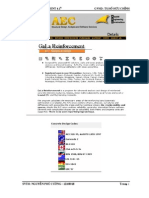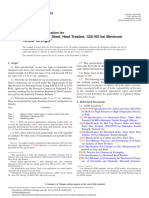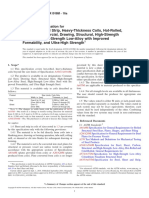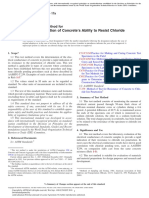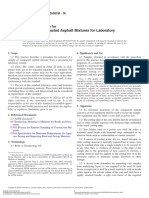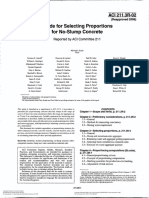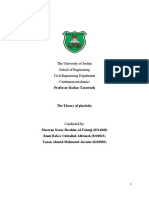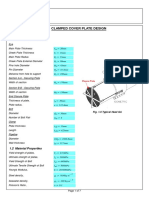Astm A143
Astm A143
Uploaded by
asdrecvCopyright:
Available Formats
Astm A143
Astm A143
Uploaded by
asdrecvOriginal Title
Copyright
Available Formats
Share this document
Did you find this document useful?
Is this content inappropriate?
Copyright:
Available Formats
Astm A143
Astm A143
Uploaded by
asdrecvCopyright:
Available Formats
Designation: A143/A143M − 07 (Reapproved 2014)
Standard Practice for
Safeguarding Against Embrittlement of Hot-Dip Galvanized
Structural Steel Products and Procedure for Detecting
Embrittlement1
This standard is issued under the fixed designation A143/A143M; the number immediately following the designation indicates the year
of original adoption or, in the case of revision, the year of last revision. A number in parentheses indicates the year of last reapproval.
A superscript epsilon (´) indicates an editorial change since the last revision or reapproval.
This standard has been approved for use by agencies of the U.S. Department of Defense.
1. Scope 2. Referenced Documents
1.1 This practice covers procedures that can be followed to 2.1 ASTM Standards:2
safeguard against the possible embrittlement of steel hot-dip F606 Test Methods for Determining the Mechanical Proper-
galvanized after fabrication, and outlines test procedures for ties of Externally and Internally Threaded Fasteners,
detecting embrittlement. Conditions of fabrication may induce Washers, and Rivets (Metric) F0606_F0606M
a susceptibility to embrittlement in certain steels that can be
3. Terminology
accelerated by galvanizing. Embrittlement is not a common
occurrence, however, and this discussion does not imply that 3.1 Definitions:
galvanizing increases embrittlement where good fabricating 3.1.1 embrittlement, n—the loss or partial loss of ductility in
and galvanizing procedures are employed. Where history has a steel where an embrittled product characteristically fails by
shown that for specific steels, processes and galvanizing fracture without appreciable deformation; types of embrittle-
procedures have been satisfactory, this history will serve as an ment usually encountered in galvanized steel are related to
indication that no embrittlement problem is to be expected for aging phenomena, cold working, and absorption of hydrogen.
those steels, processes, and galvanizing procedures.
4. Factors in Embrittlement
1.2 This practice is applicable in either inch-pounds or SI 4.1 Embrittlement or loss of ductility in steel is often
units. Inch-pounds and SI units are not necessarily exact associated with strain-aging. Strain-aging refers to the delayed
equivalents. Within the text of this practice and where increase in hardness and strength, and loss of ductility and
appropriate, SI units are shown in brackets. impact resistance which occur in susceptible steels as a result
1.3 This standard does not purport to address all of the of the strains induced by cold working. The aging changes
safety concerns, if any, associated with its use. It is the proceed slowly at room temperature, but proceed at an accel-
responsibility of the user of this standard to establish appro- erated rate as the aging temperature is raised and may occur
priate safety and health practices and determine the applica- rapidly at the galvanizing temperature of approximately 850°F
bility of regulatory limitations prior to use. [455°C].
4.2 Hydrogen embrittlement may also occur due to the
possibility of atomic hydrogen being absorbed by the steel. The
1
This practice is under the jurisdiction of ASTM Committee A05 on Metallic- susceptibility to hydrogen embrittlement is influenced by the
Coated Iron and Steel Products and is the direct responsibility of Subcommittee type of steel, its previous heat treatment, and degree of
A05.13 on Structural Shapes and Hardware Specifications.
Originally Prepared by Subcommittee A05.10 on Embrittlement Investigation of
previous cold work. In the case of galvanized steel, the acid
Committee A05 on Corrosion of Iron and Steel and based on an investigation made pickling reaction prior to galvanizing presents a potential
by Battelle Memorial Institute under American Society for Testing and Materials’ source of hydrogen. However, the heat of the galvanizing bath
sponsorship. See Proceedings, Am. Soc. Testing Mats., Vol 31, Part I, 1931, p. 211;
also paper by Samuel Epstein, “Embrittlement of Hot-Dip Galvanized Structural
2
Steel,” see Proceedings, Am. Soc. Testing Mats., Vol 32, Part II, 1932, p. 293. For referenced ASTM standards, visit the ASTM website, www.astm.org, or
Current edition approved Aug. 1, 2014. Published September 2014. Originally contact ASTM Customer Service at service@astm.org. For Annual Book of ASTM
approved in 1932. Last previous edition approved in 2007 as A143/A143M – 07. Standards volume information, refer to the standard’s Document Summary page on
DOI: 10.1520/A0143_A0143M-07R14. the ASTM website.
--````,,,``,```,`,```,``,,,`,`-`-`,,`,,`,`,,`---
Copyright © ASTM International, 100 Barr Harbor Drive, PO Box C700, West Conshohocken, PA 19428-2959. United States
Copyright ASTM International
Provided by IHS Markit under license with ASTM
1Licensee=Enterprise Wide -rest of new locations/5940240048, User=kahraman, safak
No reproduction or networking permitted without license from IHS Not for Resale, 11/09/2017 06:53:17 MST
A143/A143M − 07 (2014)
partially expels hydrogen that may have been absorbed. In forming, etc., it is advisable to limit the thermal treatment to
practice hydrogen embrittlement of galvanized steel is usually stress relieving at a maximum of 1100°F [595°C] to avoid
of concern only if the steel exceeds approximately 150 ksi excessive grain growth or alternatively to fully normalize the
[1100 MPa] in ultimate tensile strength, or if it has been steel at temperatures from 1600 to 1700°F [870 to 925°C]. The
severely cold worked prior to pickling. time at temperature should be approximately 1 h/in.
4.3 Loss of ductility of cold-worked steels is dependent on [24 min ⁄cm] of section thickness.
many factors including the type of steel (strength level, aging 6.4 Flame cut copes on structural beams shall have a
characteristics), thickness of steel, and degree of cold work, minimum radius of 1 in. [2.5 cm]. After cutting, the cut surface
and is accentuated by areas of stress concentration such as shall be ground to remove notches, grooves, and irregular
caused by notches, holes, fillets of small radii, sharp bends, etc. surface features to leave the surface smooth.
4.4 Low temperatures increase the risk of brittle failure of 7. Preparation for Galvanizing
all plain carbon steels including steel that has been galvanized.
The rate at which this temperature loss of ductility occurs 7.1 Hydrogen can be absorbed during pickling and in some
varies for different steels. The expected service temperature instances, as noted in 4.2, may contribute to embrittlement of
should thus be taken into account when selecting the steel. the galvanized product. The likelihood of this, or of surface
cracking occurring, is increased by excessive pickling
5. Steels temperature, prolonged pickling time, and poor inhibition of
5.1 Open-hearth, basic-oxygen, and electric-furnace steels the pickling acid. Heating to 300°F [150°C] after pickling and
shall be used for galvanizing. Other materials that can be before galvanizing in most cases results in expulsion of
galvanized include continuous cast slabs, steel or iron castings, hydrogen absorbed during pickling.
and wrought iron. 7.2 Abrasive blast cleaning followed by flash pickling may
also be employed when over-pickling is of concern or when
6. Cold Working and Thermal Treatment very high strength steel, ultimate tensile strength higher than
6.1 For intermediate and heavy shapes, plates, and 150 ksi [1100 MPa], must be galvanized. The abrasive blast
hardware, cold bend radii should not be less than that which is cleaning does not generate hydrogen while it is cleaning the
proven satisfactory by practice or by the recommendations of surface of the steel. The flash pickling after abrasive blast
the steel manufacturer. These criteria generally depend on the cleaning is used to remove any final traces of blast media
direction of grain, strength, and type of steel. A cold bending before hot-dip galvanizing.
radius of three times (3×) the section thickness, or as recom-
mended in AISC Manual of Steel Construction,3 will ordinarily 8. Responsibility for Avoiding Embrittlement
ensure satisfactory properties in the final product. Although 8.1 Design of the product and selection of the proper steel to
sharper bending on thin sections can usually be tolerated, withstand normal galvanizing operations without embrittle-
embrittlement may occur if cold bending is especially severe. ment are the responsibility of the designer. The fabricator shall
If the design requires sharper bending than discussed herein, be responsible for employing suitable fabrication procedures.
the bending should be done hot, or if done cold the material The galvanizer shall employ proper pickling and galvanizing
should be subsequently annealed or stress relieved as noted in procedures.
6.3.
9. Testing for Embrittlement of Steel Shapes, Steel
6.2 Smaller shapes, including thickness up to 1⁄4 in. Castings, Threaded Articles, and Hardware Items
[6.4 mm] may be cold worked by punching without subsequent
annealing or stress-relieving. Shapes 5⁄16 to 11⁄16 in. [8 to 9.1 Subject to base material and dimensional limitations, the
18 mm] in thickness are not seriously affected as to service- tests given in 9.2, 9.3, 9.4, or 9.5, or a combination thereof,
ability by cold punching or if the punching is done under good shall apply. If one test specimen should be found embrittled by
shop practice. The heavier shapes, 3⁄4 in. [19 mm] and over, these tests, two additional specimens should be tested. Failure
shall be reamed with at least 1⁄16 in. [1.6 mm] of metal removed of either the second or the third specimen shall be cause for
from the periphery of the hole after punching, or shall be rejection of the lot (see Note 1) that the samples represent.
drilled, or thermally treated prior to galvanizing as noted in 6.3. NOTE 1—A lot is a unit of production from which a sample may be
taken for testing. Unless otherwise agreed upon by the manufacturer and
6.3 Fabrication in accordance with the principles outlined in
--````,,,``,```,`,```,``,,,`,`-`-`,,`,,`,`,,`---
the purchaser, or established within this practice, the lot shall be as
6.1 and 6.2 will normally obviate the need for thermal follows: For test at a manufacturer’s facility, a lot is one or more articles
treatment. However, if required, proper thermal treatment shall of the same type and size comprising a single order or a single delivery
precede galvanizing of the steel. For heavy cold deformation load, whichever is the smaller, or a smaller number of articles identified as
exemplified by cold rolling, sheared edges, punched holes, or a lot by the manufacturer, when these have been galvanized within a single
production shift. For test by purchaser after delivery, the lot consists of the
cold-formed rods and bolts, subcritical annealing at tempera- single order or the single delivery load, whichever is the smaller, unless
tures from 1200 to 1300°F [650 to 705°C] should be employed. the lot identity, established in accordance with the above, is maintained
For less severe cold deformation typified by cold bending, roll and clearly indicated in the shipment by the manufacturer.
9.2 A bend test for embrittlement of galvanized steel hard-
3
Available from American Institute of Steel Construction (AISC), One East ware such as bolts, pole and tower steps, braces, rods,
Wacker Drive, Suite 3100, Chicago, IL 60601-2001. 9th Edition. reinforcing bars, etc., consists of bending the article and
Copyright ASTM International
Provided by IHS Markit under license with ASTM
2Licensee=Enterprise Wide -rest of new locations/5940240048, User=kahraman, safak
No reproduction or networking permitted without license from IHS Not for Resale, 11/09/2017 06:53:17 MST
A143/A143M − 07 (2014)
comparing the degree of bending to that which is obtained on 9.4.2.1 The test shall be made in a universal testing
a similar ungalvanized article. The article, before and after machine, or by other means such as a press with the load
galvanizing, may be clamped in a vise and using a lever if applied slowly, until fracture of the galvanized test specimen
necessary, bent until cracking of the base steel occurs, or to 90° occurs. The length of the test specimen and the distance
whichever is less. The galvanized article should withstand a between the supports are shown in the following table:
degree of bending substantially the same as the ungalvanized Leg of Angle, l, in. [mm] Length Between Minimum Length, L2,
article. Flaking or spalling of the galvanized coating is not to (see Fig. 1) Supports, L1, in. [mm]
in. [mm]
be construed as an embrittlement failure. For threaded articles, Up to 4 [102], incl 14 [356] 18 [457]
the test shall be made on the unthreaded portion. Over 4 to 6 [102 to 152], incl 20 [508] 24 [610]
Over 6 to 8 [152 to 203], incl 30 [762] 36 [914]
9.3 Small steel castings and steel hardware of such shape or
size that do not permit bending may be struck a sharp blow 9.4.2.2 After the test, the distance along the gage length
with a 2-lb [1-kg] hammer and the results for both galvanized from each punch mark to the corresponding edge of the
and ungalvanized samples compared. If the article withstands fracture shall be measured to 0.01 in. [0.25 mm] with a flexible
such a blow in the ungalvanized condition, but after galvaniz- scale and the percentage of elongation calculated from the sum
ing cracks under the blow, it shall be considered embrittled. of these distances.
9.4.2.3 For determining the percentage reduction of thick-
9.4 A test for embrittlement of galvanized steel angles is ness after fracture, the reduction shall be measured with a
detailed as follows: ball-point micrometer at the three locations indicated in Fig. 2:
9.4.1 Test Specimen—A test specimen with a length deter- namely a, outer side of hole; b, inner side of hole; and c,
mined by the table in 9.4.2.1 and by Fig. 1 shall be cut from the middle of leg. The percentage reduction of thickness shall be
steel angle before galvanizing. A hole shall be made in the test calculated on the basis of the original thickness of the angle
specimen at its midlength, using the same procedure as will be and the average of the three values at a, b, and c.
employed in the fabricated material which the specimen 9.4.2.4 The test shall be made upon galvanized specimens
represents, whether this be by punching, punching and having a temperature not below 60°F [16°C] and not over 90°F
reaming, or drilling. The dimensional values, diameter, and [32°C] when tested.
location of hole shall be not less than those employed in the 9.4.3 Requirements—The elongation measured in accor-
structural details. Care should be taken not to place the hole dance with 9.4.2.2 shall be not less than 5 % with the following
near stamped or rolled-in identification marks. The specimen exception: when the specimen does not show 5 % elongation,
shall then be galvanized. For determining the elongation after the reduction in thickness shall be measured in accordance with
fracture, a 2-in. [51-mm] gage length (Fig. 1) shall be prick- 9.4.2.3. The sum of the percentage of elongation plus the
punched in the middle of the edge of the vertical leg of the average percentage reduction of thickness shall not be less than
galvanized angle along a line parallel to its length and centered 10.
directly under the hole. For specimens under 1⁄2 in. [13 mm] in
--````,,,``,```,`,```,``,,,`,`-`-`,,`,,`,`,,`---
thickness, or those in which the distance from the edge of the 9.5 For hot-dip galvanized externally threaded fasteners, an
hole to the edge of the angle is less than 3⁄8 in. [10 mm], a 1-in. alternate test to 9.2 for embrittlement is detailed in Test Method
[25-mm] gage length shall be used. F606.
9.4.2 Procedure: 10. Keywords
10.1 coatings-zinc; galvanized coatings; steel products-
metallic coated; zinc coatings-steel products
NOTE 1—2 in. = 51 mm.
FIG. 1 Specimen for Elongation after Fracture FIG. 2 Measurement of Reduction of Thickness after Fracture
Copyright ASTM International
Provided by IHS Markit under license with ASTM
3Licensee=Enterprise Wide -rest of new locations/5940240048, User=kahraman, safak
No reproduction or networking permitted without license from IHS Not for Resale, 11/09/2017 06:53:17 MST
A143/A143M − 07 (2014)
ASTM International takes no position respecting the validity of any patent rights asserted in connection with any item mentioned
in this standard. Users of this standard are expressly advised that determination of the validity of any such patent rights, and the risk
of infringement of such rights, are entirely their own responsibility.
This standard is subject to revision at any time by the responsible technical committee and must be reviewed every five years and
if not revised, either reapproved or withdrawn. Your comments are invited either for revision of this standard or for additional standards
and should be addressed to ASTM International Headquarters. Your comments will receive careful consideration at a meeting of the
responsible technical committee, which you may attend. If you feel that your comments have not received a fair hearing you should
make your views known to the ASTM Committee on Standards, at the address shown below.
This standard is copyrighted by ASTM International, 100 Barr Harbor Drive, PO Box C700, West Conshohocken, PA 19428-2959,
United States. Individual reprints (single or multiple copies) of this standard may be obtained by contacting ASTM at the above
address or at 610-832-9585 (phone), 610-832-9555 (fax), or service@astm.org (e-mail); or through the ASTM website
(www.astm.org). Permission rights to photocopy the standard may also be secured from the Copyright Clearance Center, 222
Rosewood Drive, Danvers, MA 01923, Tel: (978) 646-2600; http://www.copyright.com/
--````,,,``,```,`,```,``,,,`,`-`-`,,`,,`,`,,`---
Copyright ASTM International
Provided by IHS Markit under license with ASTM
4Licensee=Enterprise Wide -rest of new locations/5940240048, User=kahraman, safak
No reproduction or networking permitted without license from IHS Not for Resale, 11/09/2017 06:53:17 MST
You might also like
- Astm C926Document14 pagesAstm C926asdrecv75% (4)
- Astm e 1264Document4 pagesAstm e 1264asdrecv100% (1)
- Astm A536-84 2019 PDFDocument6 pagesAstm A536-84 2019 PDFRio Witcandra100% (2)
- Astm A143a143m.20Document4 pagesAstm A143a143m.20safak kahraman100% (1)
- Astm C90Document5 pagesAstm C90asdrecv100% (2)
- Astm A480-A480m (2022)Document25 pagesAstm A480-A480m (2022)faruk öztürk100% (3)
- Astm A 123 17 PDFDocument9 pagesAstm A 123 17 PDFVu Ba100% (2)
- ASTM B564 (2011) - Standard Specification For Nickel Alloy ForgingsDocument11 pagesASTM B564 (2011) - Standard Specification For Nickel Alloy Forgingsanoop100% (1)
- Aisc 303-05Document16 pagesAisc 303-05hetpinNo ratings yet
- Astm G101-04 (2020)Document9 pagesAstm G101-04 (2020)AnrStuk50% (2)
- Aashto M294Document19 pagesAashto M294asdrecv100% (1)
- Aashto M294Document19 pagesAashto M294asdrecv100% (1)
- Astm A123 2013 PDFDocument8 pagesAstm A123 2013 PDFjoao carlos protz100% (2)
- ASTM A385-Providing High-Quality Zinc Coatings (Hot-Dip)Document8 pagesASTM A385-Providing High-Quality Zinc Coatings (Hot-Dip)trjithinraj100% (3)
- A1011 - 18aDocument9 pagesA1011 - 18aalucard375100% (1)
- ASTM-A449: Licensed by Information Handling Services Licensed by Information Handling ServicesDocument7 pagesASTM-A449: Licensed by Information Handling Services Licensed by Information Handling ServicesRoland CepedaNo ratings yet
- Welded and Seamless Steel Pipe Piles: Standard Specification ForDocument7 pagesWelded and Seamless Steel Pipe Piles: Standard Specification ForDang Thanh TuanNo ratings yet
- Astm A700Document40 pagesAstm A700hegiro2011No ratings yet
- Astm A53 A53mDocument23 pagesAstm A53 A53mRaviprakash Chauhan100% (2)
- Astm A-449Document8 pagesAstm A-449Anonymous GhPzn1x100% (2)
- Astm F606 PDFDocument16 pagesAstm F606 PDFEnrike Garcia100% (1)
- Astm G 48Document9 pagesAstm G 48nisha_khanNo ratings yet
- Astm F668Document2 pagesAstm F668Mahfuz AlamNo ratings yet
- Astm B308 - B308M 10Document6 pagesAstm B308 - B308M 10Harold NaiborhuNo ratings yet
- Astm A759 PDFDocument3 pagesAstm A759 PDFCristian OtivoNo ratings yet
- Astm d4101Document17 pagesAstm d4101asdrecvNo ratings yet
- Astm C270Document14 pagesAstm C270asdrecv100% (4)
- C88 2013Document5 pagesC88 2013manil_5No ratings yet
- Practise Exam CBA PDFDocument11 pagesPractise Exam CBA PDFasdrecvNo ratings yet
- Ebook Introduction Gala4.1Document24 pagesEbook Introduction Gala4.1Lê Ngọc-HàNo ratings yet
- Astm A 143 A143m-2007Document3 pagesAstm A 143 A143m-2007Fabio SegattoNo ratings yet
- Astm A 385 PDFDocument9 pagesAstm A 385 PDFNizarHamrouniNo ratings yet
- Astm G101-04 PDFDocument8 pagesAstm G101-04 PDFJoel Angel100% (1)
- Astm F436M.-11Document5 pagesAstm F436M.-11abhishek yadav100% (1)
- Astm A572Document4 pagesAstm A572Jonathan Arley Vega LopezNo ratings yet
- Astm A106 PDFDocument13 pagesAstm A106 PDFDanny Milton Silva VasquezNo ratings yet
- Astm A193-A193m-20Document14 pagesAstm A193-A193m-20Viviana LeonNo ratings yet
- ASTM A123 and CSA G164 - COMPARISONDocument7 pagesASTM A123 and CSA G164 - COMPARISONPubcrawlNo ratings yet
- Astm A767-09Document5 pagesAstm A767-09poulmackNo ratings yet
- Astm A240 PDFDocument15 pagesAstm A240 PDFReza SaeeNo ratings yet
- Astm A563Document9 pagesAstm A563mhmgola100% (1)
- Astm A449Document9 pagesAstm A449Fabricio Noronha100% (1)
- Astm A780 PDFDocument4 pagesAstm A780 PDFFu Ad100% (1)
- D1330.17885-1 - Vol. 09.02Document2 pagesD1330.17885-1 - Vol. 09.02Jignesh TrivediNo ratings yet
- A108Document4 pagesA108Mathew CherianNo ratings yet
- ASTM A325 - Structural Bolts, Steel, Heat Treated, 120-105 Ksi Minimum Tensile Strength PDFDocument8 pagesASTM A325 - Structural Bolts, Steel, Heat Treated, 120-105 Ksi Minimum Tensile Strength PDFChemical Engineer100% (1)
- Structural Steel, Sheet and Strip, Carbon, Hot-Rolled: Standard Specification ForDocument3 pagesStructural Steel, Sheet and Strip, Carbon, Hot-Rolled: Standard Specification ForRoland CepedaNo ratings yet
- Astm A29Document16 pagesAstm A29Nacer KisyNo ratings yet
- Weld Access HoleDocument2 pagesWeld Access HoleBalwinder Singh100% (1)
- Standard Specification For: Designation: F3125/F3125M 19Document14 pagesStandard Specification For: Designation: F3125/F3125M 19Ahmed Abdelaziz100% (3)
- Astm A139Document6 pagesAstm A139william_m08100% (1)
- Astm A352-A352m-06-1Document5 pagesAstm A352-A352m-06-1Kishor JadhavNo ratings yet
- B 209Document29 pagesB 209manuel floresNo ratings yet
- Aws c4.4 c4.4m 2004 Recommended Practices For Heat Shaping and Straightening With Oxyfuel Gas HeatingDocument53 pagesAws c4.4 c4.4m 2004 Recommended Practices For Heat Shaping and Straightening With Oxyfuel Gas HeatingKara White0% (1)
- Stainless Steel Nuts: Standard Specification ForDocument8 pagesStainless Steel Nuts: Standard Specification ForChris MedeirosNo ratings yet
- A 1018 - A 1018M - 16aDocument8 pagesA 1018 - A 1018M - 16aJose Anisio Silva0% (1)
- Astm A6Document5 pagesAstm A6SHYAM SINGHNo ratings yet
- Astm A 563 2014Document9 pagesAstm A 563 2014Marlonnog100% (2)
- Astm F593Document8 pagesAstm F593fcoespinosa100% (2)
- Astm A501 PDFDocument2 pagesAstm A501 PDFgamin100% (1)
- Astm A668Document10 pagesAstm A668Riky AyalaNo ratings yet
- ASTM A 516 - A 516M Pressure Vessel PlateDocument4 pagesASTM A 516 - A 516M Pressure Vessel PlatebonnicoNo ratings yet
- Asme Ii Sfa 5. 32Document16 pagesAsme Ii Sfa 5. 32yogliolivares100% (2)
- A252Document7 pagesA252Luz DuarteNo ratings yet
- Astm 143Document3 pagesAstm 143JH_ProjectNo ratings yet
- Safeguarding Against Embrittlement of Hot-Dip Galvanized Structural Steel Products and Procedure For Detecting EmbrittlementDocument4 pagesSafeguarding Against Embrittlement of Hot-Dip Galvanized Structural Steel Products and Procedure For Detecting EmbrittlementLucas O. AquinoNo ratings yet
- Astm A 143 - 03Document3 pagesAstm A 143 - 03Glenys MuñozNo ratings yet
- A 143 – 74 R99 ;QTE0MY9BMTQZTS1SRUQ_Document6 pagesA 143 – 74 R99 ;QTE0MY9BMTQZTS1SRUQ_quatudogonNo ratings yet
- Astm A 143M-03Document3 pagesAstm A 143M-03MritunjayNo ratings yet
- Providing High-Quality Zinc Coatings (Hot-Dip) : Standard Practice ForDocument9 pagesProviding High-Quality Zinc Coatings (Hot-Dip) : Standard Practice ForBaoNo ratings yet
- Astm c1202Document8 pagesAstm c1202asdrecv100% (1)
- Astm d4429 RevaDocument7 pagesAstm d4429 Revaasdrecv0% (1)
- Astm d2950Document4 pagesAstm d2950asdrecv100% (1)
- Astm d5361Document3 pagesAstm d5361asdrecvNo ratings yet
- Astm C117Document4 pagesAstm C117asdrecv100% (1)
- Aci 211.3RDocument26 pagesAci 211.3Rasdrecv100% (1)
- Astm A194 A194m - 13Document12 pagesAstm A194 A194m - 13Danilo YamaguchiNo ratings yet
- Heat TreatmentDocument33 pagesHeat TreatmentColeNo ratings yet
- Final Report PlasticityDocument45 pagesFinal Report PlasticityriganNo ratings yet
- Quiz 2 PDFDocument7 pagesQuiz 2 PDFRuth Montebon0% (1)
- Aircraft Structures 2Document11 pagesAircraft Structures 2api-3848439100% (2)
- Callister Ch09Document90 pagesCallister Ch09Nemish KanwarNo ratings yet
- AFE SettlementAnalysis 2013 WebDocument134 pagesAFE SettlementAnalysis 2013 Webntah84100% (1)
- Local BucklingDocument14 pagesLocal Bucklingrajdeep_saha_1No ratings yet
- Adsorption by J. RouquerolDocument79 pagesAdsorption by J. RouquerolTravis MorrisonNo ratings yet
- Tables For EN 10216-2 PDFDocument18 pagesTables For EN 10216-2 PDFAli BariNo ratings yet
- 5.MMC, CMC, CCCDocument22 pages5.MMC, CMC, CCCwladimir ramrezNo ratings yet
- This Kisssoft Demoversion May Not Be Used For Professional Application ! Important Hint: at Least One Warning Has Occurred During The CalculationDocument7 pagesThis Kisssoft Demoversion May Not Be Used For Professional Application ! Important Hint: at Least One Warning Has Occurred During The Calculationpablo_stzNo ratings yet
- ثيسس ستركجر معدل د شاكرDocument5 pagesثيسس ستركجر معدل د شاكرlaith aliNo ratings yet
- In Uence of Cobalt Introduction On The Phase Equilibrium and Sintering Behavior of Lithium-Ion Conductor Li Al Ti (PO)Document8 pagesIn Uence of Cobalt Introduction On The Phase Equilibrium and Sintering Behavior of Lithium-Ion Conductor Li Al Ti (PO)FERNANDO DE LA PUENTENo ratings yet
- Design of Rigid Pile Caps Through An Iterative Strut-And-Tie ModelDocument12 pagesDesign of Rigid Pile Caps Through An Iterative Strut-And-Tie ModeljjohnsoneNo ratings yet
- Journal of Alloys and CompoundsDocument12 pagesJournal of Alloys and CompoundsTalita SouzaNo ratings yet
- FEMA 451 Compl - Struct Analysis Performance-BasedDocument85 pagesFEMA 451 Compl - Struct Analysis Performance-BasedGeorge Sanches100% (2)
- OFF-Axis Mechanical Properties of FRP CompositesDocument6 pagesOFF-Axis Mechanical Properties of FRP CompositesSabin RautNo ratings yet
- Investigation of Physical, Mechanical and Tribological Properties of Al6061-Zro Metal Matrix CompositesDocument10 pagesInvestigation of Physical, Mechanical and Tribological Properties of Al6061-Zro Metal Matrix CompositesPushpa Latha MNo ratings yet
- Tangent Law: Category: JEE Main & AdvancedDocument13 pagesTangent Law: Category: JEE Main & AdvancedTanmay HazraNo ratings yet
- FBD Vs DBDDocument13 pagesFBD Vs DBDLekhraj MeenaNo ratings yet
- Hand Calcs Rs15 - DeckliftDocument5 pagesHand Calcs Rs15 - DeckliftPalani KarthiNo ratings yet
- Wide Width Tensile StrengthDocument4 pagesWide Width Tensile StrengthMohit SharmaNo ratings yet
- 371 Home%2Bwork%2B3 2015Document3 pages371 Home%2Bwork%2B3 2015Ramiz KurbegovicNo ratings yet
- Second Law of Thermodynamics-NotesDocument19 pagesSecond Law of Thermodynamics-Notesmanil raj100% (13)
- 17-Residual Stress and DistortionDocument20 pages17-Residual Stress and DistortionSaif UllahNo ratings yet
- Clamped Cover Plate DesignDocument7 pagesClamped Cover Plate DesignChiedu OkonduNo ratings yet
- Plastic Analysis HWDocument11 pagesPlastic Analysis HWBors CostinNo ratings yet
- FE Simulation of Engine Head Block For Structural DurabilityDocument19 pagesFE Simulation of Engine Head Block For Structural DurabilityPankaj Gambhire100% (2)




























